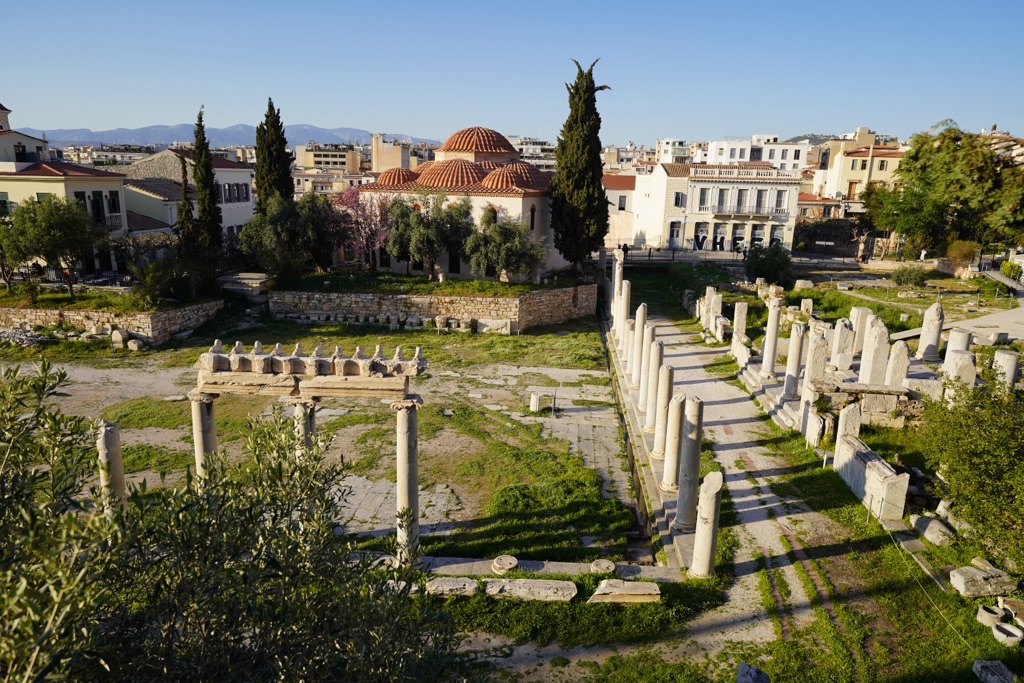The Agora of Athens stands as a testament to the bustling heart of ancient Athenian democracy, commerce, and social life. This open square, located at the northwest of the Acropolis, served as a public space where citizens gathered to discuss politics, philosophy, and day-to-day affairs. Over time, it evolved into a significant archaeological site, offering a window into the civic life of ancient Greece. The Agora’s remains, including various buildings and structures, reflect the architectural and historical significance of this pivotal space in the development of Western civilization.
Get your dose of History via Email
Historical Background of the Agora of Athens
Archaeologists unearthed the Agora of Athens in the 19th century, revealing its historical layers. American School of Classical Studies at Athens led the primary excavations in the 1930s. The Agora’s roots trace back to the 6th century BC, established by the ancient Athenians. It became the focal point of public life in Athens.
Renowned figures like Pericles and Socrates frequented the Agora, contributing to its legacy. It witnessed pivotal moments, such as the birth of democracy. The Agora saw various phases of construction and destruction, reflecting Athens’ turbulent history. Romans and Byzantines later inhabited the area, leaving their marks.
Historically, the Agora was the scene of significant events, including political gatherings and trials. It was here that Socrates faced his trial and subsequent execution. The Agora also hosted athletic competitions and theatrical performances, showcasing its multifaceted role in Athenian society.
Throughout its history, the Agora was repeatedly rebuilt and renovated. This was due to various invasions and destructions, including the sack of Athens by the Persians in 480 BC and later by the Herulians in AD 267. Each reconstruction phase added new structures, reflecting the changing needs and aesthetics of the time.
The Agora remained in use until the 6th century AD. After that, it fell into decline and was eventually abandoned. Over the centuries, buildings collapsed, and the area was buried under debris, obscuring its former glory until its rediscovery and excavation in modern times.
About the Agora of Athens
The Agora of Athens was the hub of ancient Athenian life, with its expansive layout and diverse structures. It was a multifunctional space, accommodating political, commercial, and social activities. The Agora’s design was open and accessible, encouraging the free flow of ideas and people.
Key architectural highlights include the Stoa of Attalos, reconstructed to house the Agora Museum, and the Hephaisteion, a well-preserved temple. The use of marble and limestone was prevalent in the construction of the Agora’s buildings. These materials stood the test of time, allowing us to witness the grandeur of ancient Greek architecture.
The Tholos, the Bouleuterion, and the Metroon were significant structures within the Agora. They served as administrative buildings, central to the functioning of Athenian democracy. The Agora also featured altars, statues, and fountains, contributing to its aesthetic and religious significance.
Construction methods of the Agora reflected the advanced engineering skills of the ancient Greeks. They employed techniques that ensured the durability and beauty of their structures. The layout of the Agora was strategic, facilitating the various activities that took place within its confines.
Over time, the Agora underwent numerous modifications to meet the evolving needs of Athenian society. These changes are evident in the archaeological layers, telling the story of a dynamic and adaptable public space that was central to the life of the city.
Theories and Interpretations
The Agora of Athens has been the subject of various theories and interpretations. Scholars have debated its uses and significance throughout history. The Agora was primarily a place for political discourse and decision-making, as suggested by the presence of numerous civic buildings.
Some theories propose that the Agora was also a space for commercial activities. Evidence of shops and marketplaces supports this view. The Agora’s role in social and religious gatherings is well-documented, with altars and temples indicating its multifaceted nature.
Mysteries surround certain aspects of the Agora, such as the exact functions of some lesser-known structures. Historians have had to match archaeological findings with ancient texts to piece together the Agora’s story. This process has sometimes led to differing interpretations of its purpose and layout.
Dating of the Agora’s structures has been carried out using methods like stratigraphy and pottery analysis. These techniques have helped establish a timeline for the construction and use of the Agora. They have also aided in understanding the chronological development of Athenian society.
Theories about the Agora continue to evolve as new discoveries are made. Each finding adds to our understanding of this complex and historically rich site. The Agora remains a focal point for studies on ancient Greek urban planning and public life.
At a glance
Country: Greece
Civilization: Ancient Greece
Age: Established in the 6th century BC
Conclusion and Sources
Reputable sources used in creating this article include:
- Wikipedia: https://en.wikipedia.org/wiki/Ancient_Agora_of_Athens
- World History Encyclopedia: https://www.worldhistory.org/agora/

